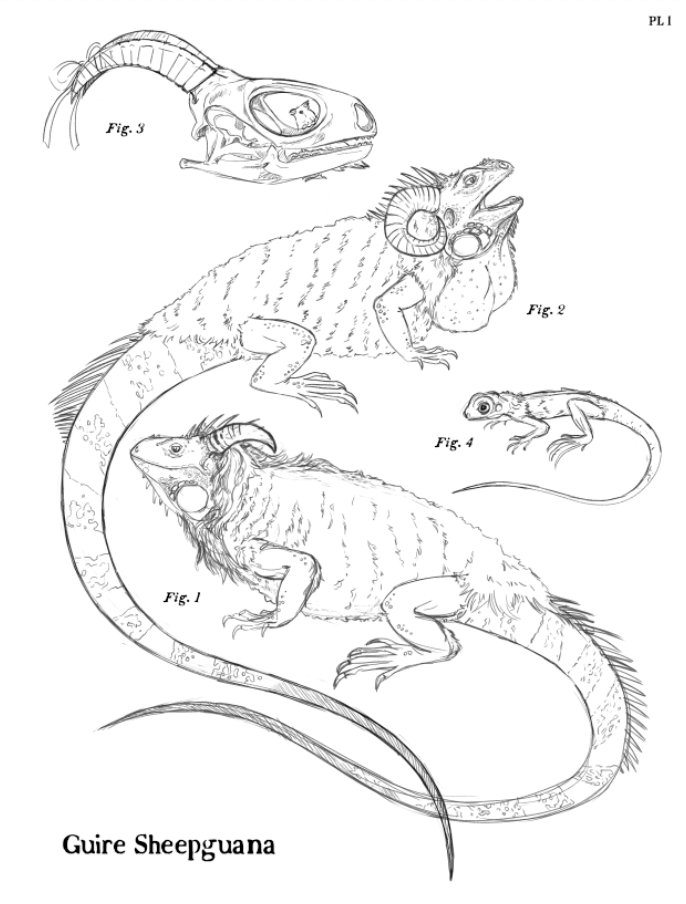
- Fig. 1: Adult Eweguana
- Fig. 2: Adult Ramguana
- Fig. 3: Eweguana Skull; from Shrine of Matriarchs past; colour of ribbon denotes flock
- Fig. 4: Lambguana
The next subspecies we shall discuss are the Guire sheepguana that live in and around the forests of the western kingdoms. Their wool is tough and tends to form a dense outer surface to discourage the tangling of burrs, twigs and other debris in the fleece. The most notable thing about the breed, however, is the fact that a wild population is required in the area if one is to maintain a flock beyond one generation. As is usual in sheepguana, every flock is led by an experienced matriarch and near those forests full of wild beasts and old magic, her cunning is even more vital to the welfare of the flock. What is peculiar in the Guire however is the matter of her succession. With other breeds, upon the death of the matriarch another wise eweguana, often one of her daughters, will rise to assume her mantle and indeed this seems to be how matters procede with Guire herds that live apart from birds as well. But in a domesticated flock, tended and cared for by its faithful guardian, this has never been seen to happen. Instead, the flock will enter what is best described as a period of mourning and confusion, after which it will dissolve; with individuals or small groups leaving to join other flocks or even the wild herds.
The only way to keep the flock together is to find a new matriarch, similar to introducing a new queen into a beehive. Thus, when a lead ewe dies or shows signs of succumbing to old age, either the flock’s guardian or, more often, their apprentice will pack a few days’ food, a blanket woven from the old matriarch’s wool, and some hay from their pasture and venture into the woods in search of a wild herd. This is frequently the last that is ever seen of the hopeful apprentice, as the forest is dangerous and many prefer exile to the shame of returning alone. If they do find a herd, they will present their offering of their pasture’s grazing and plead with the matriarch for her blessing. If they are found worthy, a young ewe, sometimes accompanied by a few other sheepguana, will accept them as her new guardian and follow them back to join the flock. Following a surprisingly short introductory period, the orphaned flock will readily defer to her as the new matriarch. Nobody knows how Guire recognize whatever quality marks a ewe for leadership or why it never arises in flocks living with birds, although there are naturally numerous opinions on the matter. Ask a bard and they will tell you stories of hidden shrines to forgotten gods or magical springs hidden deep in the forests, usually followed by offers to sell you an ancient map to the place on which the ink hasn’t quite dried yet. More serious scholars have proposed that it may be triggered by confronting dangers that the more sheltered domesticated flocks do not encounter, such as owlbear attacks. A final conclusion is unlikely to be found anytime soon, as this would require observing a wild herd for an extended amount of time and none of the research teams that have attempted it returned without losing either their notes, their sanity, their lives or all three.
In fact, those readers familiar with the western woods may be surprised that any prospective flock guardians have survived long enough to find a herd and return with a new matriarch. Indeed their high rate of success is due to the feeding habits of the wild Guire which allow them to be tracked in a fashion.
Being ground dwelling ruminants that like to bask in the sun, sheepguana in general are ill suited to living in forests. Therefore the Guire have taken to using their fiery breath to create clearings in which to graze and absorb the sun. Over time they will carefully burn and topple single trees along one edge of their clearing while at the other end new trees, well fertilized by the sheepguana’s excrement, are allowed to grow. Over the course of years, a herd of Guire will in this fashion slowly meander through the forests, rejuvenating them in their wake. This migration can be very disruptive to animals that make their home in the deep forest as they are slowly pushed back by the encroaching clearings. Animals such as boars will often retreat into the very corners of their territory until the blaze of the sheepguana’s efforts finally causes them to take sudden, terrified flight. In their panic, the beasts will often run great distances and even intrude upon avain settlements before finding a new home. Massed sightings of fleeing wildlife are thus a reliable sign that a herd of sheepguana is close. Upon hearing of such incursions, the pilgrims will take up the trail of the wild animals and seek to follow it back to the sheepguana and their clearing, avoiding much of the risk of randomly scouring the forest. Since these groups of wild animals play such a crucial role in maintaining the flocks, they are considered signs from the gods and an indication of divine favour for the farmers whose land they visit. It is thus with great respect and no little envy that the villagers of the western reaches look upon him who may say: “Lo, thyrty to fyftey feral Högs didst rush into my yard this morning!”
Read on to the next chapter to learn the fable of foolish king Dönal the Jaundiced who vowed to build the mygtiest and most grande wall in all the lands to stop sheepguana from entering his kingdom, thus depriving his people of much prosperity.